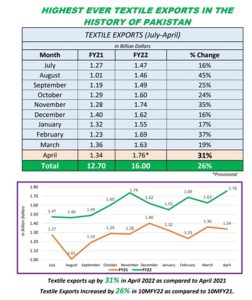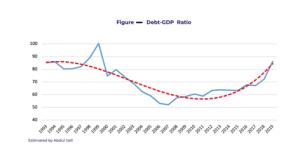The solution to Pakistan’s perpetual BOP, fiscal, and debt issues that have led it repeatedly to the IMF is the sustained acceleration of export-led growth. Sustainable development and economic growth necessitate export-led growth, as a strong export base serves as a self-sufficient and highly beneficial method to strengthen the economy without external debt. In Pakistan’s context, the textile sector provides a reliable pathway to counter the debt that has accumulated from consecutive loans.
The most effective mechanisms to sustain export-led growth include product and market diversification, improvements in quality, and integration into global value chains. Government support is naturally an essential component in ensuring these policies are implemented and institutionalized, leading to a successful economic future for Pakistan.
Read more: Pakistan: The economic focus
Understanding the actual matter
The need for the development of an export culture in Pakistan is often overlooked by policymakers who tend to seek out short-term economic fixes. These fixes can not steer sustainable growth for Pakistan’s economy, and the same is to be said of seeking IMF loans and bailouts. For decades, we have sought loans to achieve economic stability, which tends to be conditional and very difficult to repay. Meanwhile, policymakers have neglected the local business community – particularly the export-oriented industry – which has the potential to steer sustainable economic growth as long as it is provided with basic policy support, and in particular, competitively priced energy.
According to the latest PBS data, Pakistan’s trade deficit crossed $39 billion in the first 10 months of the current fiscal year, as the rate of increase in imports was twice the surge in exports. The 10-month trade deficit was $15.4 billion – over two-thirds more than the same period of the previous year.
The World Bank’s Pakistan Development Update, released in April, postulates that while economic activity remained strong from July-December 2021, pressures of high demand and rising global commodity prices resulted in double-digit inflation and a steep rise in imports. These developments adversely impacted the rupee. These issues are exacerbated by structural weaknesses in the economy such as low investment, low exports, and low productivity growth.
The report highlights that rising food and energy prices are expected to decrease the real purchasing power of households, disproportionally affecting poor and vulnerable households that spend a larger share of their budget on these items. Meanwhile, excess government borrowing from the financial sector crowds out the supply of credit to the private sector and deepens the sovereign-bank nexus.
Read more: Why exports in Pakistan need special attention?
How these problems can be resolved?
Resolving these constraints in the medium to long term requires concerted efforts by the government, regulators, and other stakeholders, and the most sustainable way to counteract them is by building Pakistan’s export culture. Export enhancement has proven time and again to be the only effective economic solution, as exhibited by the ability of the textile sector to achieve record numbers despite the constraints and lack of an export culture in Pakistan, illustrated in the charts below.

Greater exports are the only mechanism to break the begging bowl and achieve real economic and political sovereignty. Pakistan must target higher economic growth by prioritizing value-addition, particularly in the highly productive textile sector, which is the backbone of the economy and where regionally competitive energy is the primary path towards real progress. Export-oriented industries proved the critical role of these tariffs, by immediately showing an upward trend in production, creating new jobs and reaching full capacity for several months when competitive energy rates were applied.
Enhanced trade competitiveness leading to an increase in exports is undoubtedly a sustainable path to economic growth, as, unlike aid, it is not tied up in liability. Remittances are also an unreliable metric to tie hopes of economic growth to, as the rise and fall of remittances is unpredictable in the long run. The earnings through exports serve as a valuable inflow to the economy and will pull Pakistan out of its current account deficit and economic stagnation.

Value addition, competitive inputs and trade competitiveness can effectively result in sustainable economic growth; as unlike aid, these measures are free of any liability. Earnings through enhanced exports serve as a valuable inflow to the economy, and can pull Pakistan out of its current account deficit and economic stagnation. Job creation is another crucial metric for an economy in the growth stage, as yearly increases in unemployment must be catered to.
The important measures
The private sector provides us with a viable means to achieve this, as export-oriented sectors are highly labour intensive. The textile sector creates jobs in every tier of the economy, as different skills are required at each stage, be it cotton picking, ginning, stitching, designing, innovating or strategic planning. The expansion and development of exporting industries thereby reduces unemployment in addition to being essential for a healthy Balance of Payments.
In the longer term, policy that prioritizes an export culture in Pakistan, specifically supporting industrial growth and productivity, can help to substantially boost the economy. Supporting the growth of large-scale manufacturing industries, especially textiles, where there is evidence of comparative advantage for Pakistan, would therefore be critical moving forward.
Read more: Pakistan’s National Electricity Plan 2022-2026 in perspective
It is essential to note that the value of exports is just as important as the volume, and this signals product diversification and entry into high-value-added goods. The government needs to work in tandem with major exporters to incentivize diversification while removing institutional roadblocks and barriers to growth that have held the exporting sectors back from realizing maximum potential.
Written by: Shahid Sattar and Eman Ahmed
Mr. Shahid Sattar, now Executive Director & Secretary General of All Pakistan Textile Mills Association (APTMA), has previously served as Member Planning Commission of Pakistan and an advisor to the Ministry of Finance, Ministry of Petroleum, Ministry of Water & Power.
Eman Ahmed is a Research Analyst at APTMA.
The views expressed by the writers do not necessarily represent Global Village Space’s editorial policy














